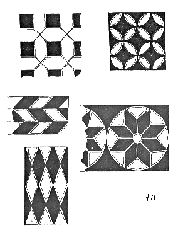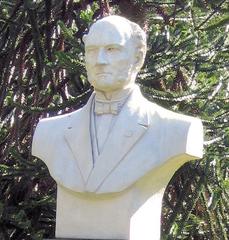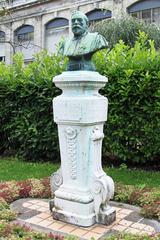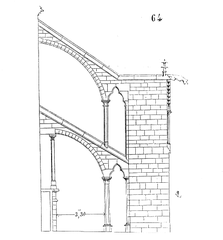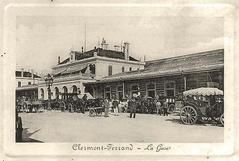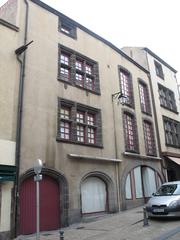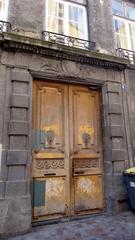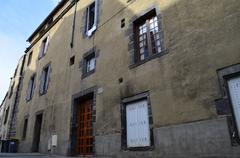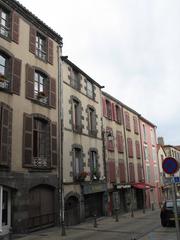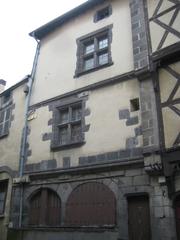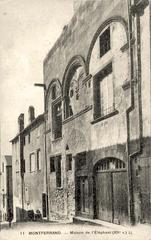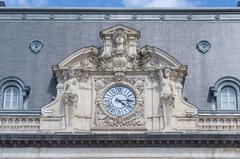Borne de Justice de Clermont-Ferrand: Visiting Hours, Tickets, and Guide to Clermont-Ferrand Historical Sites
Date: 14/06/2025
Introduction
The Borne de Justice de Clermont-Ferrand, located in the historic Montferrand district, is a unique medieval monument that offers a direct link to the city’s rich judicial and cultural history. Dating from the 15th century, this justice boundary stone is both a symbol of royal authority and an artifact of Clermont-Ferrand’s integration into the centralized French state. Crafted from the region’s iconic volcanic lava stone, the Borne de Justice stands as a testament to the city’s enduring architectural traditions and its layered past. As a classified Monument Historique since 1920, it continues to serve as a focal point for education, heritage tourism, and local identity, inviting visitors to explore Clermont-Ferrand’s unique urban heritage (Musée du Patrimoine; Monumentum; Clermont Auvergne Volcans Tourism).
Table of Contents
- What Is the Borne de Justice?
- Historical Significance
- Planning Your Visit
- Cultural and Educational Value
- Visitor FAQs
- Tips for Visitors
- Visuals and Media Recommendations
- Conclusion
- References
What Is the Borne de Justice?
The Borne de Justice is an ancient stone marker that historically defined the boundaries of judicial authority in medieval France. In Clermont-Ferrand, this marker signified the jurisdiction where royal or seigneurial courts held legal power, including the right to pass and execute judicial sentences. Today, it is a rare vestige of this judicial tradition, offering visitors a tangible connection to the city’s legal and civic history.
Historical Significance
Origins and Legal Role
Bornes de justice were erected throughout France during the medieval and early modern periods to delineate the areas where lords or bishops could dispense justice. Clermont-Ferrand’s marker is especially significant, given the city’s history as a center of secular and ecclesiastical power, and as a unification point for the formerly rival towns of Clermont and Montferrand (Musée du Patrimoine).
Symbolism and Deterrence
Placed near judicial courts or sites of execution, these stones served as powerful symbols of the law’s reach. In Clermont-Ferrand, the Borne de Justice’s location underscored the seriousness of legal authority and provided a visible reminder of the consequences for breaking the law.
Decline and Preservation
The centralization of judicial power under the French monarchy and the abolition of feudal privileges during the Revolution led to the decline of such markers. The survival of Clermont-Ferrand’s Borne de Justice is exceptional, preserved as a historical monument and protected as part of France’s national heritage (Monumentum).
Planning Your Visit
Location and Accessibility
- Address: 19 rue de la Rodade, 63100 Clermont-Ferrand, France
- District: Montferrand (Faubourg de Montferrand)
- GPS: Approx. 17B Rue de la Rodade, 63100 Clermont-Ferrand
Montferrand is easily accessible by public transport, car, or on foot from the city center. The area is predominantly flat, though some cobblestone streets may require sturdy footwear. The monument is outdoors and located on a public street, making it accessible year-round to all visitors (Clermont Auvergne Volcans Tourism).
Visiting Hours and Tickets
- Hours: Open 24/7 as an outdoor monument
- Tickets: No entrance fee or ticket required
Guided Tours and Interpretation
While there is no on-site staff, the local tourist office and museums offer guided heritage tours that include the Borne de Justice. Check with the Clermont Auvergne Volcans Tourist Office for current schedules.
Nearby Attractions
- Maison de l’Elephant: Medieval house on Rue Kléber
- Église Notre-Dame de Montferrand: Romanesque church
- Musée d’Art Roger-Quilliot: Fine arts museum
- Historic squares and timber-framed houses: Explore Montferrand’s medieval streets
Combining your visit with these sites provides a comprehensive experience of Clermont-Ferrand’s legal and architectural history (The Crazy Tourist).
Cultural and Educational Value
The Borne de Justice is a valuable educational resource, offering insight into the evolution of law, authority, and community in medieval France. Its preservation as a Monument Historique highlights the importance of even modest monuments in understanding the broader sweep of French history (POP Culture).
Visitor FAQs
Q: What are the visiting hours?
A: The monument is outdoors and open 24/7.
Q: Is there an entrance fee?
A: No, visiting the Borne de Justice is free.
Q: Where is the Borne de Justice located?
A: 19 rue de la Rodade, in the Montferrand district.
Q: Are guided tours available?
A: Yes, via the local tourist office and museums.
Q: Is the site accessible for people with disabilities?
A: The monument is on a public street and generally accessible, though some surrounding streets are cobbled.
Q: Can I take photographs?
A: Yes, photography is permitted and encouraged. Please do not climb or touch the monument.
Tips for Visitors
- Wear comfortable shoes suitable for cobblestone streets.
- Visit during daylight for the best viewing and photography.
- Explore the Montferrand district’s other historical sites to enrich your visit.
- Respect the monument and the surrounding heritage area.
- For audio guides and interactive content, consider downloading the Audiala app.
Visuals and Media Recommendations
High-quality images and virtual tours are available through the local tourism office and online platforms. Look for photos that highlight the stone’s volcanic texture and heraldic motifs, and use map resources to plan your route between historical sites (Clermont Auvergne Volcans Tourism, Monumentum).
Conclusion
The Borne de Justice de Clermont-Ferrand is a powerful symbol of the city’s medieval legal traditions and evolving civic identity. Freely accessible year-round in the Montferrand district, it invites visitors to reflect on the city’s journey through centuries of legal, social, and architectural change. Enhance your visit by exploring nearby heritage sites, joining a guided tour, and using digital resources for deeper engagement. The Borne de Justice stands not only as a monument to justice but as a bridge between past and present in Clermont-Ferrand’s vibrant urban fabric.
References
- Discover the Borne de Justice in Clermont-Ferrand: History, Tickets, and Nearby Attractions, 2025 (Musée du Patrimoine)
- Borne de Justice de Clermont-Ferrand: History, Architecture, and Visitor Information, 2025 (Criminocorpus)
- Borne de Justice Clermont-Ferrand: Visiting Hours, Access, and Historical Insights, 2025 (Clermont Auvergne Volcans Tourism)
- Discover the Borne de Justice in Clermont-Ferrand: History, Visiting Hours, and Travel Tips, 2025 (Monumentum)
- France.fr - Official tourism website of Clermont-Ferrand, 2025 (France.fr)
